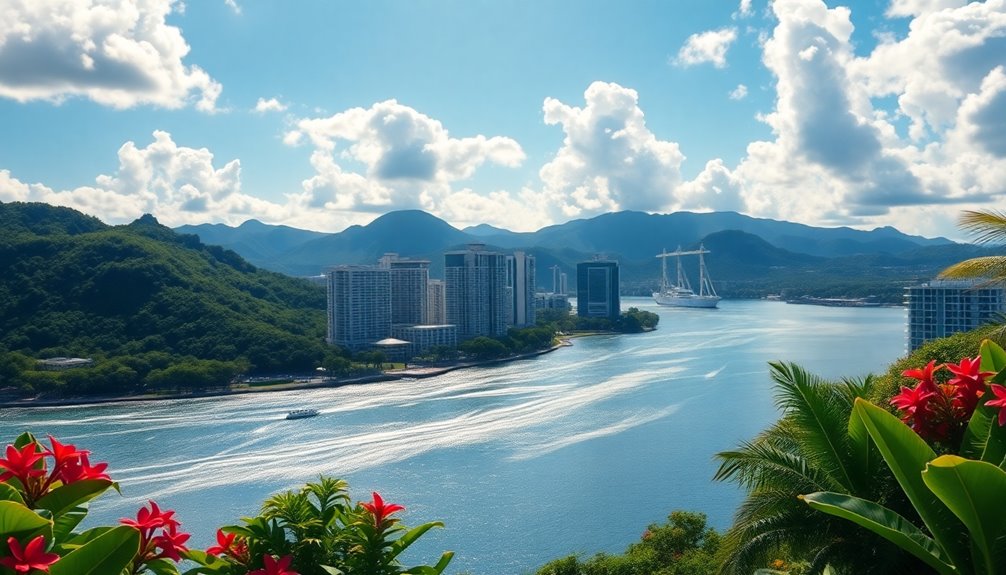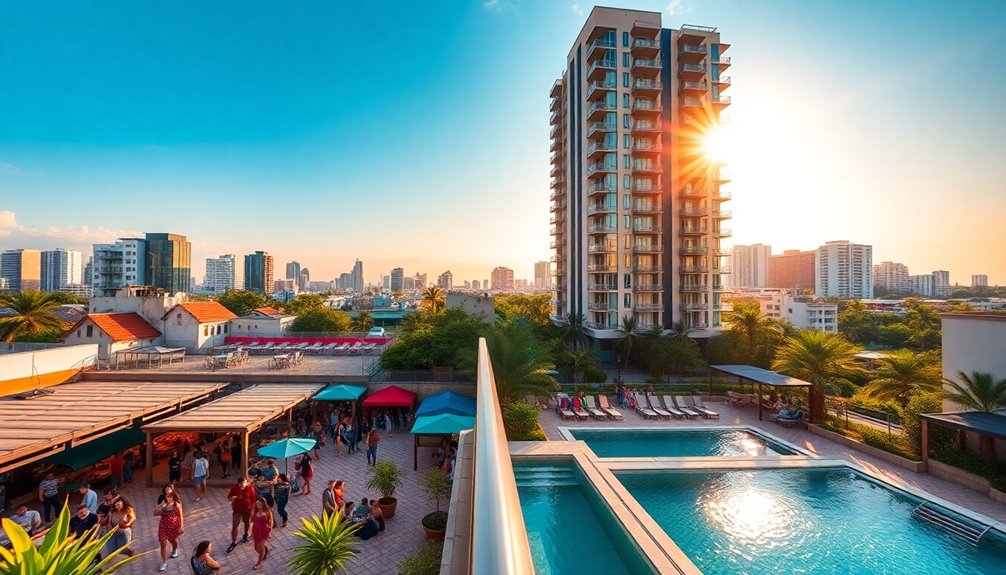The Panama property market offers exciting prospects, from the historic Canal Zone to attractive coastal areas. Recent investments in infrastructure boost demand and enhance urban living. You'll find a growing interest in luxury properties, especially in Panama City and coastal regions like Coronado. The government supports foreign investors with favorable tax policies and initiatives for affordable housing. Although challenges like market oversupply exist, overall rental yields remain strong, particularly in prime areas. As you explore further, you'll discover deeper insights into market dynamics and future growth potential across this vibrant landscape.
Key Takeaways
- The Panama Canal expansion boosts demand for commercial properties, enhancing the investment landscape in the Canal Zone.
- Coastal developments in areas like Coronado and Bocas del Toro are increasingly sought after for luxury properties and vacation homes.
- Urban growth, particularly in Panama City, drives housing demand, with rising interest in modern condos and residential towers.
- Infrastructure investments of $19.5 billion are set to enhance connectivity and support real estate values across the region.
- Despite challenges like oversupply, rental yields are projected to increase by 5-10% in high-demand areas by 2024.
Historical Overview of Real Estate
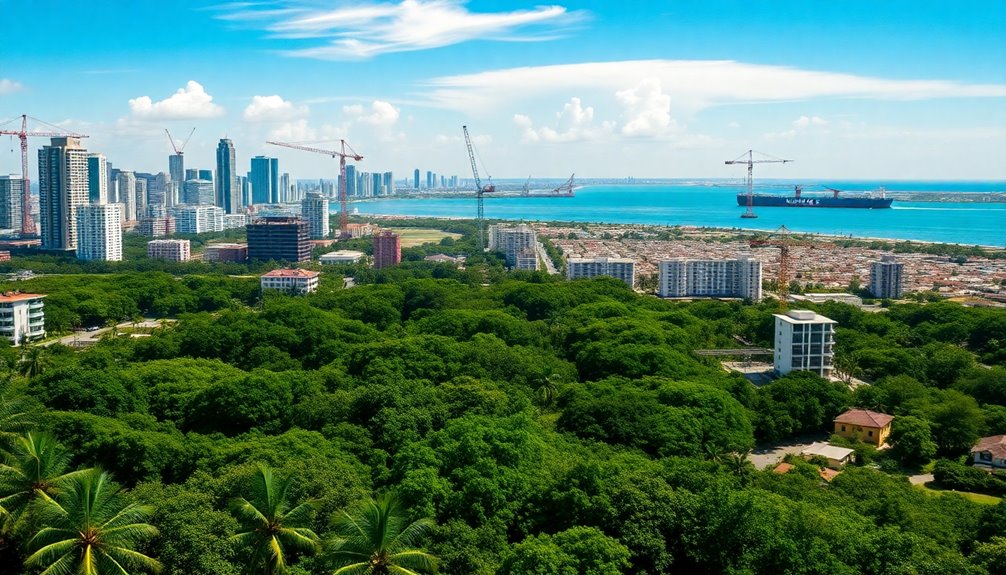
In the early 20th century, the completion of the Panama Canal in 1914 dramatically reshaped the real estate landscape in Panama. This monumental project attracted a wave of international workers and businesses, leading to rapid infrastructure and housing development.
As Panama City expanded, suburbs began to emerge, addressing the growing demand for modern living spaces. The establishment of the Colon Free Trade Zone in 1948 further boosted commercial real estate, making the region a hub for trade and business. The influx of foreign workers during the canal's construction markedly impacted local housing needs, fueling urban growth and economic expansion.
Regulatory changes, such as the Torrijos-Carter Treaties in 1977, transferred canal control to Panama, igniting national pride and investment in real estate. In addition, the economic reforms of the 1990s opened the financial sector, allowing for a surge of foreign capital inflows that invigorated the market.
The 1990s saw economic reforms that liberalized the financial sector, drawing foreign investors keen on the burgeoning market. Laws like Law 41 in 2007 incentivized multinational companies to set up regional headquarters, while restoration efforts in Casco Viejo attracted developers to preserve the area's charm.
These historical influences laid the groundwork for Panama's evolving real estate market, setting the stage for future growth and opportunities.
Key Investment Drivers

When considering investing in Panama, you'll want to focus on the key drivers that make this market appealing.
Economic stability, strategic location, and ongoing infrastructure investments are powerful factors that can enhance your investment's potential. Population growth in urban areas, particularly Panama City, is expected to drive demand for housing and commercial real estate, further bolstering the market's attractiveness.
Understanding these elements will help you navigate the property landscape effectively.
Economic Stability Factors
Many investors find Panama's economic stability to be a compelling reason to enter the property market. The country's dollar-based economy eliminates foreign exchange risks, making transactions straightforward. Low inflation rates further contribute to a stable financial environment, which is essential for long-term investments. A democratic government actively encourages foreign investment, enhancing confidence in the market.
Panama's economy is diverse, with the services sector accounting for about 80% of the GDP. This diversification helps buffer against economic shocks, evidenced by a strong performance on the Fragile State Index, showing a stable political and economic climate. Additionally, the Panama Canal expansion is driving commercial property demand, further boosting investment opportunities.
Additionally, favorable tax policies make Panama an attractive haven for investors from America, Canada, and Europe. The sovereign taxation policy guarantees no taxes are imposed beyond territorial borders, allowing foreign investors to enjoy a tax-friendly environment.
Robust infrastructure investments, totaling US$19.5 billion over the next five years, are set to enhance the country's growth. These developments not only create jobs but also support real estate demand.
With impressive GDP growth projections, Panama's property market remains resilient and poised for continued expansion, making it an appealing option for savvy investors.
Strategic Location Advantage
Panama's strategic location serves as a significant advantage for investors looking to capitalize on its property market. Nestled between North and South America, Panama acts as a global trade hub, with the Panama Canal playing a critical role in connecting the Atlantic and Pacific Oceans. This essential shipping route boosts international trade and elevates the demand for commercial and industrial properties.
Being close to major maritime routes enhances Panama's appeal for logistics and transportation investments, attracting multinational companies and financial institutions keen to seize business opportunities. The influx of expatriates seeking a vibrant lifestyle further fuels this demand.
Moreover, Panama's location boosts tourism, driving interest in holiday properties and second homes. As international visitors flock to the country, rental properties—especially in urban and beach areas—see sustained demand. Luxury resorts and upscale vacation homes are on the rise, catering to this growing market. Additionally, the anticipated increase in international visitor arrivals is expected to further stimulate the tourism sector, enhancing property investment prospects.
Lastly, Panama's easy access to Central American and Latin American markets, supported by Tocumen International Airport and the Colón Free Trade Zone, solidifies its position as a prime investment destination. This strategic advantage makes Panama's property market an enticing opportunity for savvy investors like you.
Infrastructure Investment Impact
Investing in Panama's property market is increasingly attractive due to significant infrastructure investments set to total $19.5 billion over the next five years. With 15.2% of the budget earmarked for road infrastructure and 18.9% for water and sanitation, these projects promise to enhance connectivity and living standards. Additionally, the construction sector has contributed 1.9% to GDP over the past five years, showcasing its vital role in the economy.
This surge in infrastructure development not only contributes 1.9% to the economy but also creates tens of thousands of jobs, which directly benefits local communities. As improvements unfold, remote areas will see boosted economic activity, making them more appealing to both local and foreign investors. The concentration of about 3 million people in and around Panama City drives a focus on urban infrastructure, guaranteeing a higher return on investment.
Meanwhile, initiatives targeting less developed regions, such as new roads and expanded internet access, will balance the investment landscape. A well-developed infrastructure guarantees a smoother, more predictable investment experience, enhancing the desirability and value of properties.
Engaging with local experts can help you navigate these opportunities effectively, guaranteeing you capitalize on the long-term potential of various regions transformed by ongoing projects and government initiatives.
Population Growth Impact
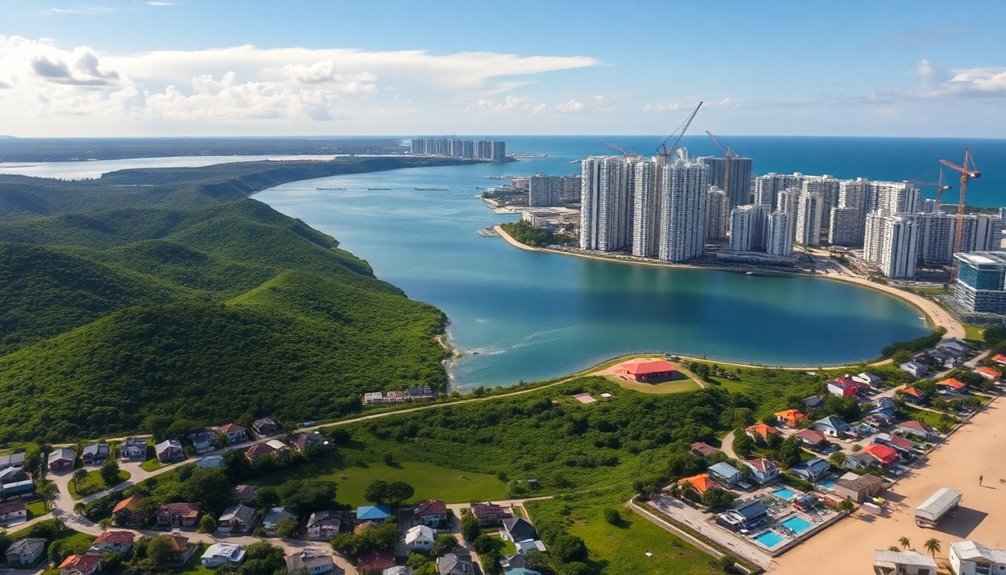
The ongoing population growth in Panama, currently at 1.34% annually, greatly influences the property market by increasing demand for housing. With a significant portion of the population concentrated in urban areas like Panama City and Colon, the need for residential and commercial spaces is on the rise.
The demographic distribution shows that 65.66% of the population is of working age, which drives economic activity and boosts housing demand. As the middle class expands and poverty decreases, more people can afford to invest in real estate. This growing wealth, coupled with a projected 5% GDP growth in 2023, stimulates interest in property investments.
With birth rates at 13.3 births per 1,000 and a death rate of 4.8 per 1,000, Panama's population is expected to continue its upward trend, further intensifying the demand for housing.
Infrastructure improvements, like those planned for roads and sanitation, enhance the attractiveness of urban areas, making them prime locations for new developments. As you navigate this evolving market, consider how these demographic shifts can present exciting opportunities in Panama's vibrant property landscape.
Rental Yields Explained

When it comes to rental yields in Panama, several factors can influence your potential earnings. You'll find that yields vary considerably between locations, with urban areas like Panama City offering different opportunities compared to coastal or mountain regions. Understanding these differences can help you make informed decisions about where to invest. For instance, the average gross rental yield in Panama is currently 6.42%, reflecting the diverse investment landscape.
Factors Influencing Rental Yields
Understanding the factors that drive rental yields in Panama can help you navigate the property market more effectively. Economic stability plays a significant role; with a Fragile State Index score of 47.5, Panama shows promising growth, including a 3% population increase and a 3.1% rise in GDP per capita over the last five years. Additionally, subscribing to real estate data can provide insights into latest market reports that inform your investment decisions. Projected growth of 5% in 2023 and 4% in 2024 further supports attractive rental yields. Furthermore, many investors find that understanding emotional support can positively influence their decision-making during market fluctuations. Risk management strategies can also enhance the stability of your investments in volatile markets.
Panama's geographical significance is another key factor. The Panama Canal and improved infrastructure make it a global trade hub, driving demand for real estate. Properties near amenities, such as golf clubs, tend to see greater interest, enhancing potential yields.
Demand dynamics also influence rental yields. Strong demand in urban and tourist areas, fueled by a growing population and increasing wealth, creates favorable conditions.
However, be cautious of oversupply in certain segments, like commercial spaces.
Lastly, the financial and regulatory environment impacts your investment returns. Gross rental yields range from 6.42% to 9.5%, but net yields are lower due to associated costs.
Understanding these factors allows you to make informed investment choices in Panama's vibrant property market.
Comparing Rental Areas
Evaluating rental yields across different areas in Panama can considerably impact your investment strategy. Understanding these variations helps you make informed decisions about where to invest.
Here's a quick comparison of rental yields across key regions:
- Urban Areas: Panama City offers gross rental yields between 5% to 8%. For instance, Bella Vista leads with approximately 8.87% for studio and 1-bedroom apartments. Additionally, high occupancy rates in popular areas enhance rental income potential.
- Coastal Areas: Locations like Coronado and Playa Blanca boast higher yields, typically ranging from 7% to 10%. These areas see fluctuating incomes due to tourist seasons, benefiting beachfront properties.
- Mountain Regions: In Boquete, yields range from 5% to 9%. Although short-term demand is lower, these properties attract long-term tenants, ensuring stable income.
- Other Regions: Panama Oeste averages around 6.13%, while the East Coast yields about 7.70% for studio and 1-bedroom apartments.
Current Market Dynamics

As Panama continues to invest heavily in infrastructure and attract foreign investment, the property market is experiencing a notable upswing. With a projected GDP growth of 5% in 2023 and significant investments in roads and sanitation, Panama’s appeal is stronger than ever. Tourists and retirees are flocking to the country, thanks to its stunning landscapes and favorable visa programs. Additionally, the demand for beachfront real estate is on the rise, particularly in areas like Coronado and Chame, making these locations increasingly desirable. The boom in the property market has also led to an increase in the demand for luxury beach homes in Mexico, with many investors looking to diversify their real estate portfolios. As a result, developers are ramping up construction efforts in popular beachfront areas, catering to the growing interest in coastal properties. With Panama’s strategic location and growing economy, it’s no surprise that beachfront real estate in the country is becoming an attractive option for both local and international buyers.
Here's a quick snapshot of the current market dynamics:
| Factor | Impact on Property Market |
|---|---|
| Infrastructure Investment | $19.5 billion over 5 years |
| GDP Growth | 5% in 2023 and 4% in 2024 |
| Tourism Demand | High demand in areas like Bocas del Toro |
| Foreign Investment | Attracted by political stability and tax benefits |
| Real Estate Activity | Increased in Panama City and coastal areas |
This combination of economic growth, tourism, and foreign investment is driving the demand for properties across the region. Whether you're eyeing a vacation home or considering a long-term investment, now's the time to explore Panama's bustling market.
Residential Trends
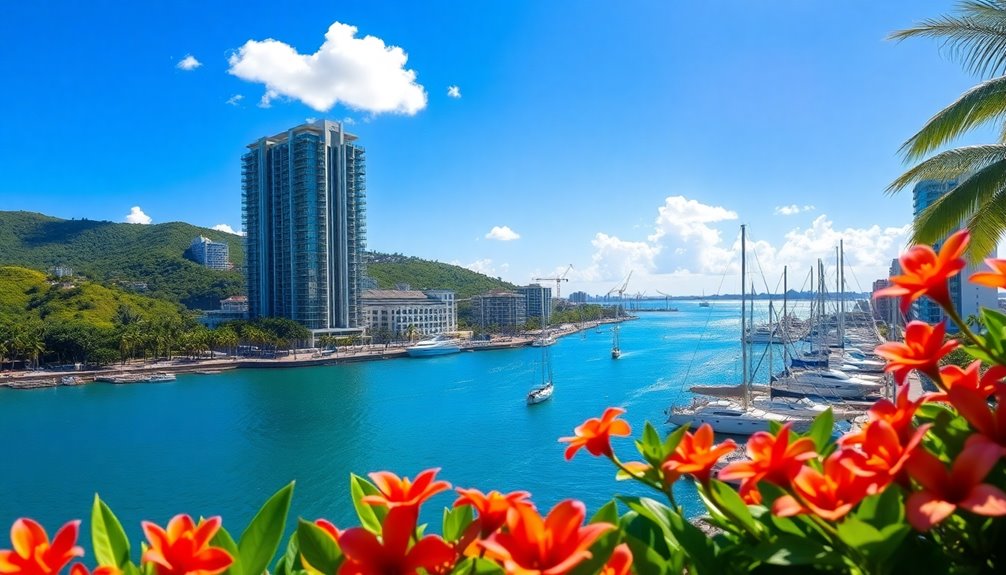
The residential trends in Panama reflect a vibrant shift towards modern living, where luxury and convenience go hand in hand.
You'll notice a growing demand for high-end properties equipped with amenities that enhance your lifestyle. Here are some key trends shaping the market:
- Luxury Living: More buyers are seeking modern and luxurious properties featuring amenities like swimming pools, gyms, and smart home technology.
- Security Focus: Properties with advanced security systems and gated communities are increasingly popular, as people prioritize safety in their living environments.
- Urban Development: In urban areas, there's a rise in residential towers and condominiums. Vertical growth is a response to limited space, with high-rises offering a range of services and amenities.
- Coastal Appeal: Coastal properties in places like Coronado and Bocas del Toro are in high demand, attracting retirees and vacationers who crave beachfront lifestyles. This growing interest is further supported by the projected market value for Panama's residential real estate, which is expected to reach US$187.30bn in 2024.
These trends underscore a dynamic shift in Panama's residential landscape, driven by a growing middle class, high-net-worth individuals, and significant infrastructure investments, making it an attractive destination for modern living.
Government Support Initiatives

In recent years, the Panamanian government has implemented several support initiatives aimed at attracting both local and foreign investors to the property market.
For foreign investors, a minimum investment of $300,000 in real estate allows you to apply for the Permanent Residence Program for Economic Reasons. You can invest in finished units or through contracts, and maintaining that investment for at least five years is essential for obtaining permanent residency. Additionally, it's important to note that after 24 months, the minimum investment increases to $500,000, ensuring continued commitment to the market.
You'll also benefit from low capital gains tax and potential property tax exemptions for up to 20 years. There are no stamp duties or HOA fees in certain turn-key deals, making investments more attractive.
For local buyers, the government has allocated $1 billion to support affordable housing, offering subsidized mortgages with interest rates considerably lower than the market average. Cash incentives are available for qualifying individuals, addressing the pressing housing supply shortfall.
Ongoing infrastructure investments, including the expansion of the Panama Canal and new metro lines, further enhance the appeal of real estate investments.
These initiatives collectively create a favorable environment for both local and foreign investors in the vibrant Panamanian property market.
Coastal Development Opportunities
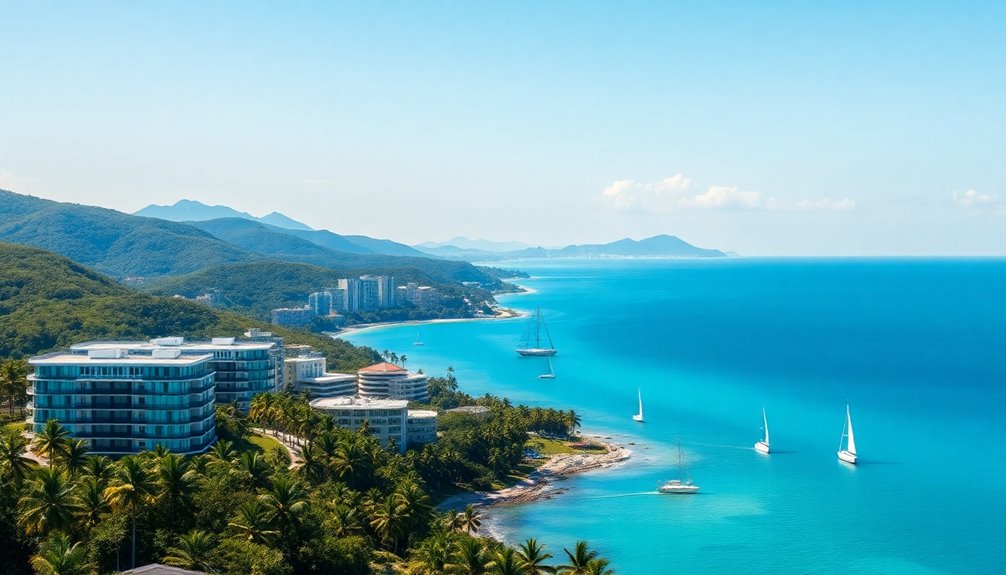
Coastal Development Opportunities
With a strong foundation laid by government support initiatives, coastal development opportunities in Panama are becoming increasingly attractive to investors and communities alike. You'll find that these projects not only enhance property values but also prioritize sustainability and community well-being. Here are some key aspects to reflect upon:
- Nature-based solutions: Incorporating mangrove ecosystems helps reduce flood risks while enhancing local biodiversity.
- Public spaces creation: New parks and multipurpose docks in neighborhoods like Boca la Caja promote community engagement and recreational activities. This initiative aims to address the issue of limited waterfront access, ensuring that more citizens can enjoy and connect with the coastal areas.
- Urban mangrove parks: Developing trails and visitor centers in urban areas like Juan Díaz and Tocumen enhances coastal resilience and accessibility.
- Social housing: Integrating social housing developments in urban plans addresses community needs while promoting inclusive growth.
As you explore these opportunities, keep in mind that the demand for beachfront properties and eco-friendly buildings is on the rise.
Challenges Facing the Market

Steering through the challenges facing the Panama property market reveals a complex landscape shaped by oversupply, economic fluctuations, and infrastructure hurdles.
You'll notice that the luxury apartment segment is grappling with an oversupply, with around 15,000 unsold units from previous years. This issue persists in commercial real estate, where 500,000 to 600,000 square meters remain vacant between 2018 and 2023, leading to a drop in rental prices by 15% to 20%.
While areas like Costa del Este and Punta Pacifica remain less affected, overall market saturation is evident. Additionally, a growing number of Americans relocating to Panama due to healthcare and housing costs is influencing demand dynamics.
Economic and political factors also play a significant role. Inflation and political changes, especially during election years, could impact investor confidence and economic stability.
Panama's reliance on the US economy further complicates the landscape, making it essential for you to stay informed about global shifts.
Lastly, infrastructure challenges threaten future growth. Delays in road projects and the need for improved public transport, like metro expansions, can hinder property values.
While ongoing investments aim to tackle these issues, the market requires a careful approach to navigate these multifaceted challenges.
Future Market Projections

The future of Panama's property market appears promising, driven by robust economic growth and significant infrastructure investments. With the economy projected to grow by 4-6% in 2023, there's a solid foundation for real estate expansion.
Here are some key projections to watch:
- The real estate market's expected growth of 1.50% from 2023 to 2028 will push the market volume to approximately $251.60 billion.
- Residential real estate will dominate, reaching an estimated volume of $182.30 billion by 2028.
- Rental prices are set to rise by 5-10% in 2024, particularly in high-demand areas like Costa del Este and Santa Maria.
- Infrastructure investments of $19.5 billion over the next five years will enhance connectivity and boost property demand.
As urban areas continue to develop, the demand for luxury properties and vacation homes in beach towns will remain strong. Furthermore, the post-2006 expansion of the Panama Canal has established Panama City as a global trade hub, further increasing interest in real estate.
With ongoing construction and the resurgence of tourism, you can expect an upward trajectory in both rental yields and property values.
Now's an exciting time to evaluate your investment options in Panama's thriving market.
Frequently Asked Questions
What Types of Properties Are Most Popular Among Foreign Investors?
When considering property investments, foreign investors often lean towards residential units like apartments and condos in urban areas for rental income.
Suburban homes and vacation rentals also attract interest for personal use.
Additionally, commercial real estate, particularly office spaces and retail properties, draws attention due to steady rental yields.
Finally, tourism-related properties, such as hotels and vacation rentals, are popular investments, especially in thriving coastal regions and areas rich in natural beauty.
How Do Property Taxes Work in Panama?
In Panama, property taxes depend on your property's value. If your property's valued up to $30,000, you won't pay any tax.
For primary residences, the first $120,000 is tax-exempt, while properties from $120,001 to $250,000 face a 0.5% tax rate. If your property exceeds $250,000, you'll pay 0.7% to 1%.
Payments are due in three installments, and you can pay online or at DGI offices for convenience.
What Financing Options Are Available for Real Estate Purchases?
Picture yourself stepping into your dream home, but first, you need financing options. You can secure a mortgage covering 60%-70% of the purchase price, with terms up to 25 years. Interest rates hover around 6.5%-9.5%, and you'll need to provide various documents.
Alternatively, consider owner financing, which offers flexibility on terms and no early payment penalties. With the right approach, you're closer to making that dream a reality!
Are There Restrictions on Foreign Ownership of Property?
Yes, there are some restrictions on foreign ownership of property.
You can't acquire properties within 10 kilometers of national borders with Costa Rica or Colombia.
Additionally, if you're looking at coastal properties, you can't make permanent improvements within certain distances from the high tide line.
It's crucial to be aware of these regulations, so you should do your research and consult a qualified attorney to navigate these restrictions effectively.
What Is the Process for Buying Property in Panama?
Imagine standing on sun-kissed shores, ready to invest in your dream property.
To buy in Panama, start by pinpointing a location that excites you. Partner with a knowledgeable real estate agent and explore matching properties.
Once you find "the one," make an offer and negotiate. Conduct thorough due diligence with a trusted attorney, sign agreements, and secure your deposit.
Finally, close the deal, ensuring your investment's future is as bright as the Panamanian sun!
Conclusion
To sum up, Panama's property market offers exciting opportunities, especially along the coast. Did you know that rental yields can reach up to 10% in some areas? This statistic highlights the potential for solid returns on investment. As population growth continues and government initiatives support development, now's the time to explore the Canal Zone and coastal properties. With challenges ahead, staying informed will help you navigate this dynamic market effectively.
